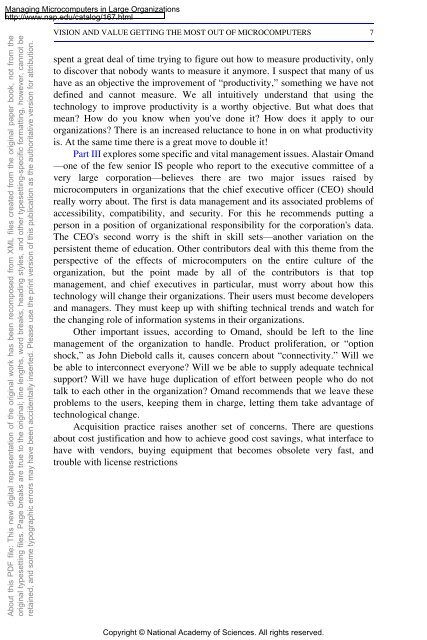Managing Computers in Large Organizations
Create successful ePaper yourself
Turn your PDF publications into a flip-book with our unique Google optimized e-Paper software.
<strong>Manag<strong>in</strong>g</strong> Microcomputers <strong>in</strong> <strong>Large</strong> <strong>Organizations</strong><br />
http://www.nap.edu/catalog/167.html<br />
About this PDF file: This new digital representation of the orig<strong>in</strong>al work has been recomposed from XML files created from the orig<strong>in</strong>al paper book, not from the<br />
orig<strong>in</strong>al typesett<strong>in</strong>g files. Page breaks are true to the orig<strong>in</strong>al; l<strong>in</strong>e lengths, word breaks, head<strong>in</strong>g styles, and other typesett<strong>in</strong>g-specific formatt<strong>in</strong>g, however, cannot be<br />
reta<strong>in</strong>ed, and some typographic errors may have been accidentally <strong>in</strong>serted. Please use the pr<strong>in</strong>t version of this publication as the authoritative version for attribution.<br />
VISION AND VALUE GETTING THE MOST OUT OF MICROCOMPUTERS 7<br />
spent a great deal of time try<strong>in</strong>g to figure out how to measure productivity, only<br />
to discover that nobody wants to measure it anymore. I suspect that many of us<br />
have as an objective the improvement of “productivity,” someth<strong>in</strong>g we have not<br />
def<strong>in</strong>ed and cannot measure. We all <strong>in</strong>tuitively understand that us<strong>in</strong>g the<br />
technology to improve productivity is a worthy objective. But what does that<br />
mean? How do you know when you've done it? How does it apply to our<br />
organizations? There is an <strong>in</strong>creased reluctance to hone <strong>in</strong> on what productivity<br />
is. At the same time there is a great move to double it!<br />
Part III explores some specific and vital management issues. Alastair Omand<br />
—one of the few senior IS people who report to the executive committee of a<br />
very large corporation—believes there are two major issues raised by<br />
microcomputers <strong>in</strong> organizations that the chief executive officer (CEO) should<br />
really worry about. The first is data management and its associated problems of<br />
accessibility, compatibility, and security. For this he recommends putt<strong>in</strong>g a<br />
person <strong>in</strong> a position of organizational responsibility for the corporation's data.<br />
The CEO's second worry is the shift <strong>in</strong> skill sets—another variation on the<br />
persistent theme of education. Other contributors deal with this theme from the<br />
perspective of the effects of microcomputers on the entire culture of the<br />
organization, but the po<strong>in</strong>t made by all of the contributors is that top<br />
management, and chief executives <strong>in</strong> particular, must worry about how this<br />
technology will change their organizations. Their users must become developers<br />
and managers. They must keep up with shift<strong>in</strong>g technical trends and watch for<br />
the chang<strong>in</strong>g role of <strong>in</strong>formation systems <strong>in</strong> their organizations.<br />
Other important issues, accord<strong>in</strong>g to Omand, should be left to the l<strong>in</strong>e<br />
management of the organization to handle. Product proliferation, or “option<br />
shock,” as John Diebold calls it, causes concern about “connectivity.” Will we<br />
be able to <strong>in</strong>terconnect everyone? Will we be able to supply adequate technical<br />
support? Will we have huge duplication of effort between people who do not<br />
talk to each other <strong>in</strong> the organization? Omand recommends that we leave these<br />
problems to the users, keep<strong>in</strong>g them <strong>in</strong> charge, lett<strong>in</strong>g them take advantage of<br />
technological change.<br />
Acquisition practice raises another set of concerns. There are questions<br />
about cost justification and how to achieve good cost sav<strong>in</strong>gs, what <strong>in</strong>terface to<br />
have with vendors, buy<strong>in</strong>g equipment that becomes obsolete very fast, and<br />
trouble with license restrictions<br />
Copyright © National Academy of Sciences. All rights reserved.


















